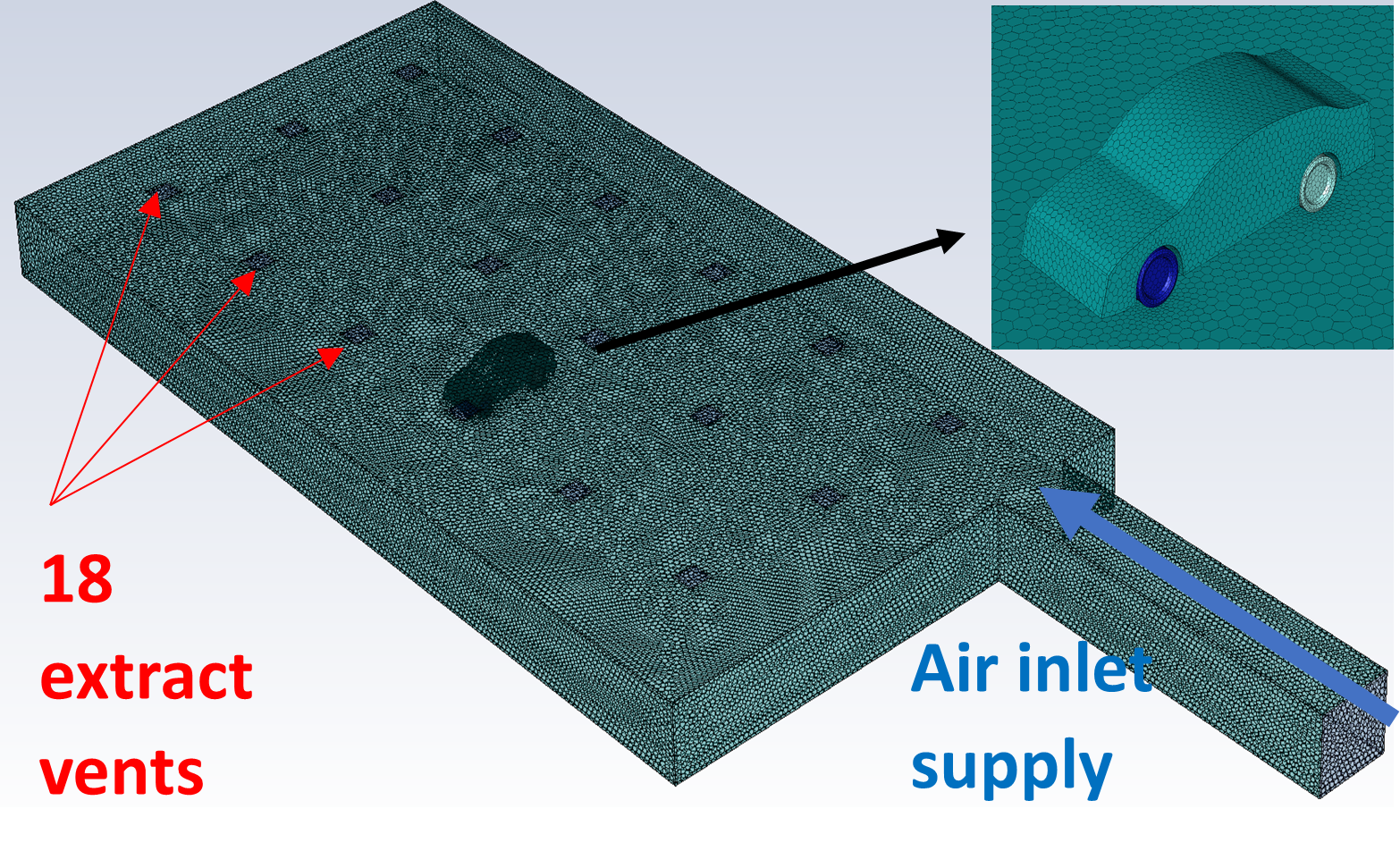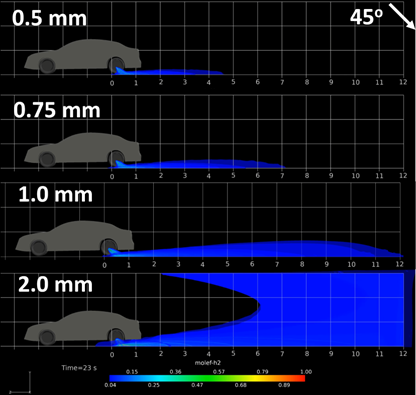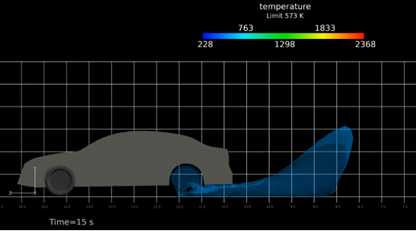Hydrogen Safety
Parametric CFD simulations for safety design optimisation
Hydrogen is considered as a potential energy carrier to replace fossil fuels. At the moment compressed gaseous hydrogen (CGH2) is considered as the most effective way to store hydrogen onboard transport applications e.g. cars, busses and trains. Present day high-pressure CGH2 tanks onboard private cars may have operating pressure 700 bar and hydrogen capacity about 5-7 kg. High pressure tank rupture in a fire is the worst-case credible incident scenario and in order to prevent it the modern regulations, codes and standards (RCS) require mandatory installation of non-reclosing thermally activated pressure relief device (TPRD) - in the event of fire TPRD would open releasing the gas and preventing catastrophic tank rupture. However, TPRD activation can create a powerful hydrogen non-reacting jet or jet fire also leading to significant hazards to human life, property and environment.
Hydrogen Safety Engineering and Research (HySAFER) Centre of Ulster University (hysafer.ulster.ac.uk) carried out numerical simulations within the project HyTunnel-CS (https://hytunnel.net) aiming to optimise TPRD design from safety viewpoint. Computational Fluid Dynamics (CFD) modelling was used to assess hazards associated with hydrogen non-reacting releases and jet fires from TPRD. The simulations were performed using EPSRC NI HPC Kelvin-2 facility and allowed to see propagation of flammable hydrogen-air composition and various thermal hazard thresholds for human life and property.
The CFD model reproduced real underground carpark (St. Martnes Latem, Gent, Belgium). Altogether 16 unignited hydrogen release and 19 ignited jet fire scenarios were simulated. Parametric studies varied TPRD design parameters, carpark ventilation rate and vehicle location:
- TPRD orifice diameter Æ5 mm, Æ1.0 mm, Æ1.5 mm, Æ2.0 mm;
- TPRD release angle to vertical 0°, 30°, 45°, 60°;
- Carpark ventilation rate, air changes per hour (ACH) 0, 10;
- Ceiling height 2.1 and 3.0 m;
- Vehicle location – in the centre of carpark and close to a wall.

Figure 1. Carpark calculation domain and surface mesh.

Figure 2. Flammable hydrogen envelope from non-reacting releases. TPRD Æ0.5 mm, Æ1.0 mm, Æ1.5 mm, Æ2.0 mm, release direction 45° to vertical, carpark height 3.0 m.
As a result of this simulation campaign TPRD release direction at the angle 45° was demonstrated to be the overall best safety solution. Unignited releases from TPRD Æ0.5 and Æ0.75 mm did not result in a flammable hydrogen-air mixture formation under the carpark ceiling, while releases from TPRDs above Æ0.75 mm have the potential to create a flammable layer. In case of hydrogen jet fire the release angle 45° and TPRD diameter Æ0.5 mm were recommended to not obstruct the vehicle evacuation and reduce the hot combustion products height. This TPRD design was also found to comply with BS 7346-7-2013 standard keeping combustion products temperature threshold 300°C far from the ventilation system intake located under ceiling. This ensures hydrogen powered vehicles compatibility with the present-day regulations, codes and standards.

Figure 3. Iso-surface of temperature threshold 300°C from hydrogen jet fire. TPRD Æ0.5 mm, release direction 45° to vertical, carpark height 3.0 m.
EPSRC NI HPC Kelvin-2 facility was indispensable in the course of this modelling campaign involving numerous incident scenarios for parametric studies and massively parallel simulations. The achieved simulation results made essential contribution to the delivery of HyTunnel-CS project and are included in its major public outcomes:
- 9 “Recommendations for inherently safer use of hydrogen vehicles in underground traffic systems”
- 10 “Recommendations for RCS”
- 4 “Harmonised recommendations on response to hydrogen accidents”
For information:
- Dmitriy Makarov (makarov@ulster.ac.uk),
- Vladimir Molkov (molkov@ulster.ac.uk),
- Volodymyr Shentsov (shentsov@ulster.ac.uk),
- Donatella Cirrone (cirrone@ulster.ac.uk).
HyTunnel-CS project received funding from the FCH2 JU (now Clean Hydrogen Partnership) under grant agreements No.826193. This Joint Undertaking receives support from the European Union’s Horizon 2020 research and innovation programme, Hydrogen Europe and Hydrogen Europe Research.
Linked publications:
- Makarov D., Cirrone D., Shentsov V., Kashkarov S., Molkov V. et al. “Overview of first outcomes of PNR project HyTunnel-CS”, Int. Conference on Hydrogen Safety, 2124 September 2021 (online, paper ID98), https://hysafe.info/uploads/papers/2021/98.pdf (assessed 21 April 2023).
- Shentsov V., Makarov D., Molkov V. “Effect of TPRD diameter and direction of release on hydrogen dispersion in underground parking”, Int. Conference on Hydrogen Safety, 21-24 September 2021 (online, paper ID88), https://hysafe.info/uploads/papers/2021/88.pdf (assessed 21 April 2023).
- Shentsov V., Cirrone D., Makarov D. “Effect of TPRD diameter and direction of release on hydrogen dispersion and jet fires in underground parking”, Journal of Energy Storage (submitted for publication).
